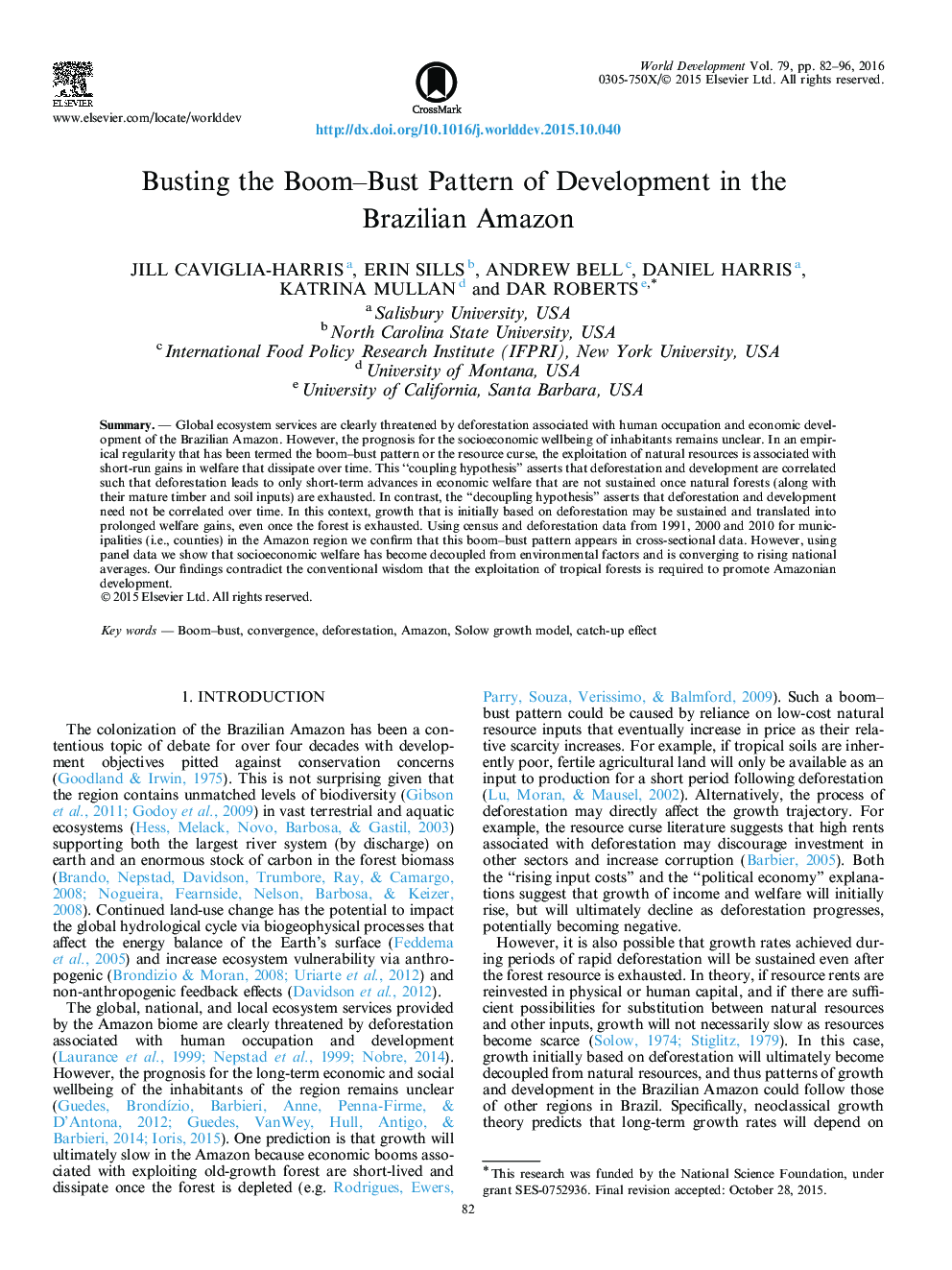| کد مقاله | کد نشریه | سال انتشار | مقاله انگلیسی | نسخه تمام متن |
|---|---|---|---|---|
| 7392900 | 1481139 | 2016 | 15 صفحه PDF | دانلود رایگان |
عنوان انگلیسی مقاله ISI
Busting the Boom-Bust Pattern of Development in the Brazilian Amazon
ترجمه فارسی عنوان
پریدن از الگوی توسعه بوم در برزیل در آمازون
دانلود مقاله + سفارش ترجمه
دانلود مقاله ISI انگلیسی
رایگان برای ایرانیان
ترجمه چکیده
خدمات اکوسیستم جهانی به وضوح توسط جنگل زدایی مرتبط با اشغال انسان و توسعه اقتصادی آمازون برزیل تهدید می شود. با این حال، پیش آگهی برای رفاه اجتماعی و اقتصادی ساکنان هنوز مشخص نیست. در منظم تجربی که الگوی رونق بوته یا لعنت منابع نامیده می شود، بهره برداری از منابع طبیعی با سود کوتاه مدت در رفاه همراه است که در طول زمان از بین می رود. این یک فرضیه اتصال؟ ادعا می کند که جنگل زدایی و توسعه همبستگی دارد، زیرا جنگل زدایی منجر به پیشرفت های کوتاه مدت در رفاه اقتصادی می شود که زمانی که جنگل های طبیعی (همراه با جنگل های بالغ و ورودی خاک) خسته می شوند، پایدار نخواهند بود. در مقابل، یک فرضیه جداسازی؟ ادعا می کند که جنگل زدایی و توسعه در طول زمان نباید با هم مرتبط باشند. در این زمینه، رشدی که در ابتدا بر روی جنگل زدایی صورت می گیرد، حتی اگر یک جنگل خسته باشد، می تواند پایدار و تبدیل به دستاوردهای رفاهی طولانی شود. با استفاده از داده های سرشماری و جنگل زدایی از سال های 1991، 2000 و 2010 برای شهرداری ها (به عنوان مثال، مناطق) در منطقه آمازون، ما تایید می کنیم که این الگوی بولت شیب در داده های مقطعی به نظر می رسد. با این حال، با استفاده از داده های پانل نشان می دهد که رفاه اجتماعی و اقتصادی از عوامل محیطی جدا شده است و همگرایی با افزایش متوسط ملی است. یافته های ما با دانش عرفانی مخالفت می کند که بهره برداری از جنگل های گرمسیری برای ارتقاء آمازون توسعه لازم است.
موضوعات مرتبط
علوم انسانی و اجتماعی
اقتصاد، اقتصادسنجی و امور مالی
اقتصاد و اقتصادسنجی
چکیده انگلیسی
Global ecosystem services are clearly threatened by deforestation associated with human occupation and economic development of the Brazilian Amazon. However, the prognosis for the socioeconomic wellbeing of inhabitants remains unclear. In an empirical regularity that has been termed the boom-bust pattern or the resource curse, the exploitation of natural resources is associated with short-run gains in welfare that dissipate over time. This “coupling hypothesis” asserts that deforestation and development are correlated such that deforestation leads to only short-term advances in economic welfare that are not sustained once natural forests (along with their mature timber and soil inputs) are exhausted. In contrast, the “decoupling hypothesis” asserts that deforestation and development need not be correlated over time. In this context, growth that is initially based on deforestation may be sustained and translated into prolonged welfare gains, even once the forest is exhausted. Using census and deforestation data from 1991, 2000 and 2010 for municipalities (i.e., counties) in the Amazon region we confirm that this boom-bust pattern appears in cross-sectional data. However, using panel data we show that socioeconomic welfare has become decoupled from environmental factors and is converging to rising national averages. Our findings contradict the conventional wisdom that the exploitation of tropical forests is required to promote Amazonian development.
ناشر
Database: Elsevier - ScienceDirect (ساینس دایرکت)
Journal: World Development - Volume 79, March 2016, Pages 82-96
Journal: World Development - Volume 79, March 2016, Pages 82-96
نویسندگان
Jill Caviglia-Harris, Erin Sills, Andrew Bell, Daniel Harris, Katrina Mullan, Dar Roberts,
